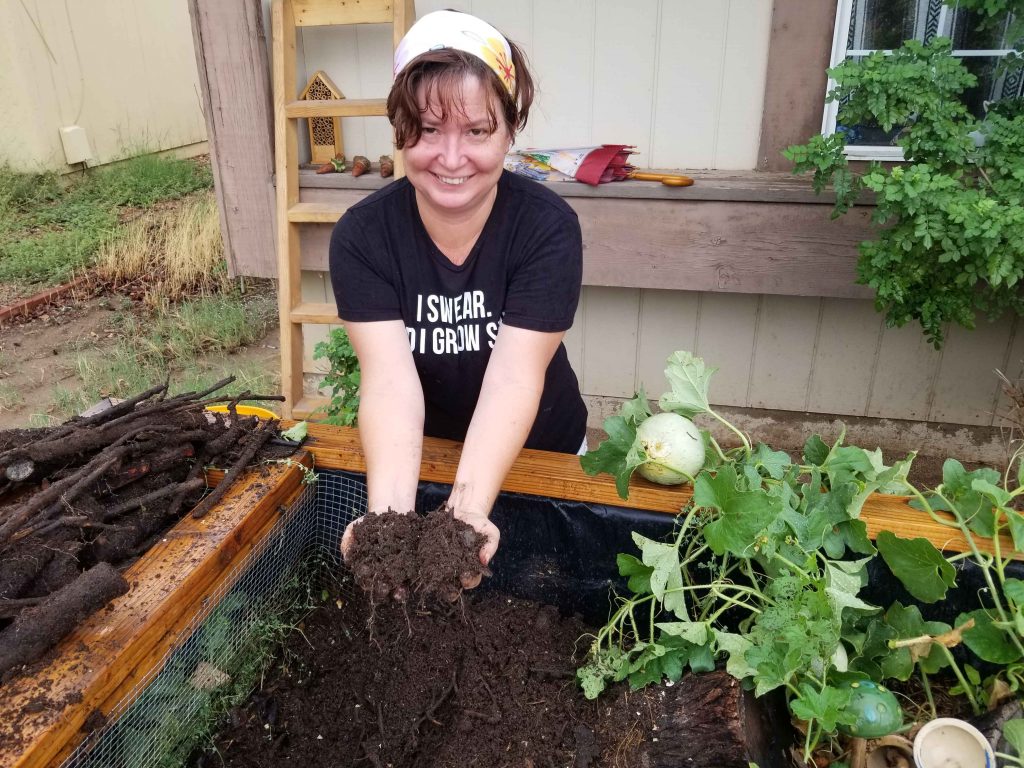
I live in Phoenix, Arizona and we have some unique challenges with our soil because of the desert conditions. Unlike soils in wetter areas, our soil is typically very high in minerals, very low in nitrogen, very low in organic matter, and has a high pH. There are two reasons for this: low rainfall, and environmental degradation.
Plants take up minerals by soaking up liquid from their roots. There are no mechanical means that plants have to absorb solids. That means that if it isn’t water soluble, it won’t be useful to plants. In wet areas, the regular rainfall can wash those nutrients away, depleting the soil of valuable minerals. In desert areas, the minerals aren’t removed so effectively. In fact, in many cases, the rains will dissolve the minerals, often calcium salts, flush them down about three feet into the soil, and then dry up, which is how caliche, a concrete-like material that is common in desert areas, forms. While these minerals are plentiful, they are often not in a form that is usable by plants.
That’s where environmental degradation comes in. There are very few natural deserts on the planet, and the Sonoran Desert certainly isn’t one. Its natural state is an arid grassland, but mismanagement by humans has desertified the climate here. The problem is that most of our institutions of higher learning that have studied agriculture and ecosystem repair over the last several hundred years are in wetter areas and the methods that work there don’t work here. In a wet area, leaving the land fallow will repair it. In a dry area, leaving land fallow increases the damage. The best way to repair the damage on a large scale is through the use of the principles espoused by Holistic Management. However, most of us just don’t have the resources needed to run large numbers of cattle on thousands of acres and instead need solutions for a smaller scale.
The main principle here is that it is the living organisms in the soil will transform the minerals in the soil into something that is going to be biologically available. These same organisms are also responsible for taking nitrogen from the atmosphere and turning it into something that plants can use.
These organisms both live in and are a part of the organic portion of the soil. If there’s no organic matter in the soil, those organisms will not exist in sufficient numbers to be helpful to the plants. The soil organic matter also has several other functions. The most important is to create soil structure. The organic component of healthy soils, typically only about 5% in high quality topsoil, opens up pores in the soil structure. This gives the soil organisms a place to live, and it allows roots and fungal threads a means to penetrate through the soil. It also allows water to soak into the soil instead of just letting it run off. In fact, an increase of soil organic matter of just 1% can allow an additional 20,000 gallons of water to infiltrate rather than run off per rain event. In fact, when we talk about how a grassland turned to desert, it is the loss of soil organic matter and the water that comes with that is the primary cause.
So now the big question becomes “how do we get the organic matter back in the soil?” I was talking with an urban farmer at a local farm incubator in Phoenix a few years ago about the lack of organic matter in the soil. He told me that over the last several years, they have dumped truckloads and truckloads of wood chips into the soil in an attempt to get the carbon content up. They have purchased tons and tons of manure and used it to amend the soil. The problem is that it just keeps burning off. So why are our extraordinary efforts to increase soil carbon having no impact? What is causing the soil carbon to burn off so quickly?
Okay, first of all, let’s deal with the big problem. This particular site tills the land several times a year. This heavy tillage destroys the soil structure, opening up carbon deep in the soil to more accessible oxygen and accelerating its breaking down. The tillage also destroys the soil organisms that are responsible for creating that soil carbon in a stable form. But that’s only the primary problem. The secondary problem is the organic matter itself. There are two ways to make soil carbon: decomposing organic matter, and the liquid carbon pathway. When you add wood chips, manure, compost, and earthworm castings to your soil, it creates an amazing abundance of living organisms in the soil. All of that carbon is food for those soil organisms. The problem is that decomposing organic matter ultimately breaks down completely. Compost is one of the most important things you can add to your soil, but you have to keep adding it. It will ultimately not result in lasting increases in soil organic matter.
If you want increases in stable soil organic matter, the only way to do it is to have an active liquid carbon pathway. This means living plants, mycorrhizal fungus on its roots, continuous plantings, no tilling, and time. So. Much. Time. See, that’s the thing. The largest component of stable soil organic matter is very durable compound called glomalin. While glomalin is very effective in very small amounts, it also takes decades to build up in any significant amount. Officially, stable soil organic matter is considered to be a non-renewable resource on a human timescale. That said, organic gardening practices, including no-till, heavy additions of compost and mulch, companion planting, inoculating with mycorrhizal fungus, and more will lead to a healthy soil structure that is rich in organic matter, has a more balanced pH, has more available nutrients, and produces healthy crops.
However, there is one way to cheat that long and arduous process forward. LEHR Soil Amplifier is a new compost product on the market. Like most composts, it is rich in organic matter and soil organisms. But there’s one big difference in LEHR Soil Amplifier compared to other composts. LEHR Soil Amplifier is made in a LEHR Garden while the plants grow in it. What this means is that the Liquid Carbon Pathway I mentioned above is active during its production. We found a lab that can test for glomalin and sent in a sample of our product and it came back with TEN TIMES the glomalin you would typically find in a healthy topsoil with high organic content. There was one study of about 120 native soils across California and LEHR Soil Amplifier has 50% more glomalin than the highest glomalin content found in that study.
While I still recommend those organic practices, the addition of LEHR Soil Amplifier can give you a head-start in your garden.
